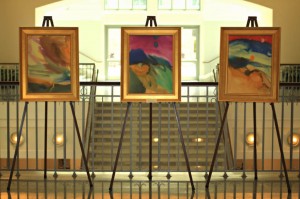The HEAL Foundation has found that creativity can alleviate autism symptoms while expanding horizons. This is part one of a three part series that looks at the positive effects the explorations of art provides children with Autism Spectrum Disorder.
Art can play an important role in the lives of many children, teens, and adults diagnosed with Autism Spectrum Disorder. It can be therapeutic, and gives the individual with autism an avenue of creativity and self-expression. The activity of art can quell many of the stimulatory behaviors caused by the disorder and be a soothing and calming exercise for the participant. Since many young children with autism have deficiencies in their gross and fine motor skills and are adverse to learning new things, teachers and parents should explore the options art offers as a therapeutic tool.
Teaming Up with Parents
Despite skyrocketing rates of autism over the past two decades, few opportunities and activities exist outside of the school setting for this growing group of students. Mothers of children with autism are legendary for banding together and pioneering new opportunities where a void exists. This was the case when a group of local, noted artists had the desire to begin an autism art program for children. The artists were Carol Lombardo, Cynthia Walburn, and Holly Green who were also mothers of children with autism.
Carol Lombardo and I became friends through our daughters who were both on the autism spectrum. I had co-founded a local non-profit foundation, The HEAL Foundation (HEALing Every Autistic Life) with my husband Bobby Weed and Dr. Julie Buckley. Carol’s daughter Lara, an artist, had become somewhat of a local celebrity in her own right by illustrating several children’s books. Carol saw how therapeutic it was for Lara to paint and draw and felt this could inspire so many children like her daughter. Carol knew art could make a difference and would open up a new world for those who had never been properly exposed to painting and drawing.
A Unique Partnership
The HEAL foundation was at the time in its infancy and was providing grants for autism camps and educational programs throughout the greater Jacksonville Area in northeast Florida. Carol approached me to see if The HEAL Foundation could provide a grant to begin art classes for autism at MOCA (the Museum of Contemporary Art in Jacksonville). I was thrilled with the prospect and as luck would have it, the director of MOCA at that time, Debbie Broder, was interested in hosting an art program for kids on the autism spectrum. Debbie asked Carol to assist her art educators on staff in developing a special art program specifically designed to meet the needs of those with autism. It was the perfect opportunity to begin a unique partnership between The HEAL Foundation and MOCA to begin an autism art program from scratch.
In the spring of 2007, The HEAL Foundation awarded its first grant to MOCA to begin a “Spring Break Art Camp.” The students were selected the first year by Carol Lombardo, who contacted the public schools/autism coordinators to get recommendations of kids who had an interest in art who would also be good candidates. The camp was free, and we limited it to eight students so as not to overwhelm the museum staff. By limiting the number, and selecting students who showed an obvious interest, we were setting up the program for success.
Expanding the Options
The artist moms continued to volunteer their time and worked at the camps to ensure the museum staff was prepared and supported. After the first year, the staff –who had never worked with kids on the spectrum –felt competent with their efforts and was ready to continue another year of art camps. The second year, they added more students, but still hand-selected them. After the completion of year two, the staff was so confident and comfortable, they decided to take it over and open it up to students anywhere on the spectrum.
Getting to that point is very important, because the museum staff needs to feel confident working with the students without outside supports in order for it to succeed. By year three the Museum had taken ownership of the program and called it their own. They named the program “The Rainbow Artist Series” and it grew each year, generating interest and funding from other sources. Eventually, the program was fully funded and became a regular museum program. It is staffed by the art educators and by volunteer parents of children on the autism spectrum to offset costs.
Stay tuned for Healing Through the Arts: Parts II & III, coming soon!




